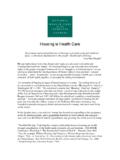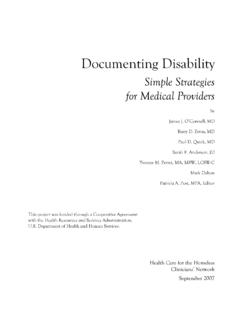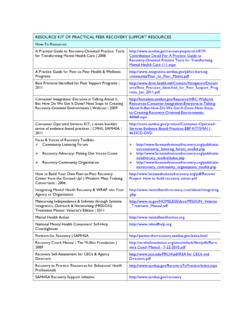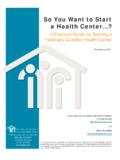Transcription of FACT SHEET JUNE 2011 - nhchc.org
1 HOMELESSNESS & health : WHAT'S THE CONNECTION? FACT SHEET JUNE 2011. The Problem: Poor health is a major cause of homelessness An injury or illness can start out as a health condition, but quickly lead to an employment problem due to missing too much time from work; exhausting sick leave; and/or not being able to maintain a regular schedule or perform work functions. This is especially true for physically demanding jobs such as construction, manufacturing, and other labor-intensive industries. Losing employment often means getting disconnected from employer-sponsored health insurance. The lack of both income and health insurance in the face of injury or illness then becomes a downward spiral; without funds to pay for health care (treatment, medications, surgery, etc.), one cannot heal to work again.
2 Of the 1 million personal bankruptcies in 2007, 62% were caused by medical debt.[1] In these situations, any savings accumulated are quickly exhausted, and relying on friends and family for assistance to help maintain rent/mortgage payments, food, medical care, and other basic needs can be short-lived. Once these personal safety nets are exhausted, there are usually very few options to help with health care or housing.[2] Qualifying for social services income support is usually only possible if there are dependent children in an extremely low-income household. Also, eligibility for Medicaid (a public health insurance program) is normally limited to small children, pregnant women, or those with a proven permanent disability (a cumbersome process that averages 22 months). Of the 50 million people who are uninsured in the , 27% are people with very low- income, and 20% are employed either full-time or part-time (increasing risk of unemployment should illness occur).
3 [3] Ultimately, the loss of housing combined with poor health , no income, and limited personal support leads to homelessness. Homelessness creates new health problems and exacerbates existing ones Living on the street or in crowded homeless shelters is personally stressful and made worse by being exposed to communicable disease ( TB, respiratory illnesses, etc.), violence, malnutrition, and harmful weather exposure.[4- 6]. Hence, common conditions such as high blood pressure, diabetes, and asthma become worse because there is no safe place to store medications or syringes properly. Maintaining a healthy diet is difficult in soup kitchens and shelters as the meals are usually high ACCESS MORE FACTS ON. in salt, sugars, and starch (making for cheap, filling meals but lacking HOMELESSNESS & health .)
4 Nutritional content).[7-8] Behavioral health issues such as depression or ONLINE. alcoholism often develop or are made worse in such difficult situations, especially if there is no solution in sight.[9] Injuries that result from violence or accidents do not heal properly because bathing, keeping bandages clean, and getting proper rest and recuperation isn't possible on the street or in shelters. Minor issues such as cuts or common colds easily develop into large problems such as infections or pneumonia.[4, 6]. Conditions among people who are homeless are frequently co-occurring, with a complex mix of severe physical, psychiatric, substance use, and social problems. High stress, unhealthy and dangerous environments, and an inability to control food intake often result in visits to emergency rooms and hospitalization which worsens overall health .
5 Thus, it is not surprising that those experiencing homelessness are three to four times more likely to die prematurely than their housed counterparts, and experience an average life expectancy as low as 41 years.[10-11]. NATIONAL health CARE FOR THE HOMELESS COUNCIL. P. O. Box 60427 | Nashville, TN 37206 | | health Care and Housing Are Human Rights Individuals experiencing homelessness have high rates of acute and chronic illness Whether a primary or contributing factor to losing housing, or a condition acquired or made worse afterwards, individuals who are homeless have disproportionately high rates of health problems. Research among patients using health centers demonstrates that even among largely low-income populations, there are significant disparities when comparing homeless and non-homeless populations (see Figure 1 below1):[12].
6 Figure 1: health Status of health Center Users 100%. 90%. 80%. 72%. 70%. 60%. 54%. 50%. 46%. 40% 38%. 32%. 30% 27%. 25%. 21% 19%. 20% 16%. 11% 11% 12%. 10%. 10% 5%. 2%. 0%. Homeless Non-Homeless *Note: Multiple chronic conditions include (2 or more of the following): hypertension, diabetes, asthma, emphysema, chronic bronchitis, heart problems, stroke, liver condition, weak/failing kidneys, cancer, and HIV/AIDS. Each of these conditions is challenging to manage, even for the general population. Absent housing, and even access to quality health care, however, they become nearly impossible to control or cure. Recovery and healing are more difficult without housing Stable housing not only provides privacy and safety, it is also a place to rest and recuperate from surgery, illness, and other ailments without worry about where to sleep, find a meal the following day, or how to balance these needs with obtaining health care and social services.
7 [13] The best, most coordinated, medical services are not very effective if the patient's health is continually compromised by street and shelter conditions. Even inpatient hospitalization or residential drug treatment, and mental health care (when available), do not have lasting impacts 1. The percentages in this chart represent the number of health center users reporting specified diagnoses out of the total for each population. NATIONAL health CARE FOR THE HOMELESS COUNCIL. P. O. Box 60427 | Nashville, TN 37206 | | health Care and Housing Are Human Rights if a client has to return to the streets upon discharge. While homeless health care providers and others in the community serving homeless populations do all they can to mitigate the effects of the streets and treat health conditions, no amount of health care can substitute for stable housing.
8 The Solution: Housing as health Care Housing and health care work together and are essential components to preventing and ending homelessness. health care services works better when a patient is housed, and in turn, maintaining housing is more likely if proper health care is available. Linking both services and housing as an ongoing approach commonly known as permanent supportive housing (PSH) is the key to addressing the dual problems of poor health and lack of housing. PSH models are proven to be cost-effective because they reduce the use of emergency rooms, hospitalization, and other public services; as well as improve overall health by preventing and managing acute and chronic disease.[14] Communities that ensure adequate and affordable housing (with or without connected services such as PSH) not only prevent and end homelessness, but also lower public costs and realize better health outcomes.
9 REFERENCES. 1. Himmelstein, , Thorne, D., Warren, E., & Woodhandler, S. (2009). Medical bankruptcy in the United States, 2007: Results of a national study. The American Journal of Medicine, p. 1-6. 2. Lewis, , Andersen, , & Gelberg, L. (2003). health care for homeless women. J Gen Intern Med,18(11): p. 921-928. 3. DeNavas-Walt, C., Proctor, , & Smith, United States Census Bureau. Income, Poverty, and health Insurance Coverage in the United States: 2009 . Issued Sept 2010. p. 60-238. Retrieved from 4. O'Connell, (Ed.) (2004). The health care of homeless persons: A manual of communicable diseases and common problems in shelters and on the streets. The Boston health Care for the Homeless Program. Retrieved from 5. Singer, J. (2003). Taking it to the streets: Homelessness, health , and health care in the United States.
10 Journal of General Internal Medicine,18(11): p. 964-965. 6. Wrezel, O. (2009). Respiratory infections in the homeless. UWO Medical Journal, 78(2): p. 61-65. 7. Burt, , Aron, , Douglas, T., et al. Homelessness: Programs and the People they Serve: Findings of the National Survey of Homeless Assistance Providers and Clients. Washington, : Interagency Council on the Homeless, Dept. of Housing and Urban Development. Dec 1999. 8. Davis, , Weller, , Jadhav, M., et al. (2008). Dietary intake of homeless women residing at a transitional living center. J health Care Poor Underserved, 19(3): p. 952-62. 9. Johnson, G. & Chamberlain, C. (2011) Are the homeless mentally ill? Australian Journal of Social Issues, 46(1): p. 29- 48. 10. Morrison, (2009). Homelessness as an independent risk factor for mortality: results from a retrospective cohort study.
















